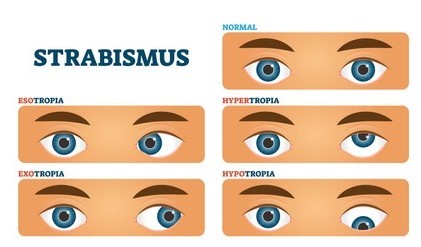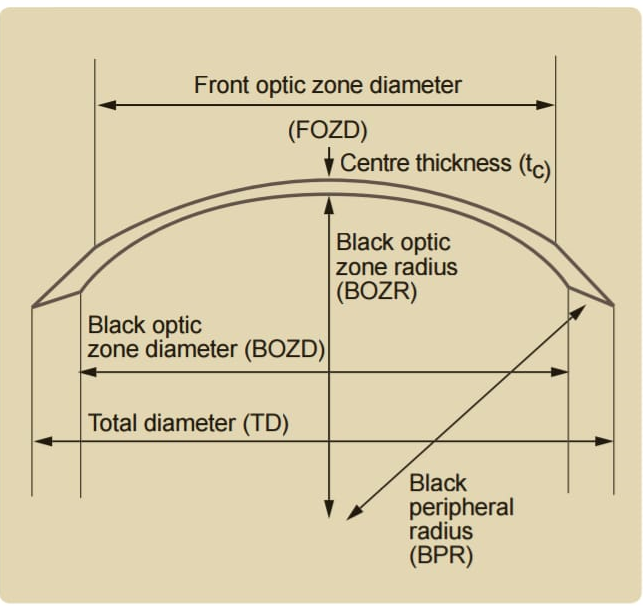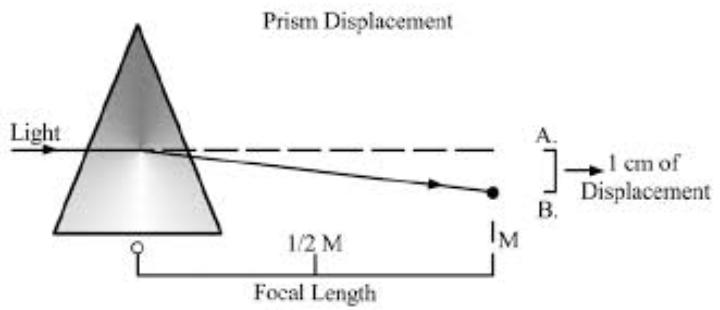OCULAR DEVIATION can be defined as misalignment of the visual axis of the two eye.
Types of ocular deviation:
•Esodeviations
•Exodeviations
•Vertical Deviations
•Cyclodeviations
ESODEVIATIONS
- Esophoria: It denotes the inward deviation of the globe only when the fusion reflex during binocular vision is interrupted.
- Esotropia: It denotes the inward deviation of the globe that cannot be overcome by fusion reflex.
Esotropia can be further divided into
- Comitant Esotropia: it is the manifest convergent deviation of the eye, in which the amount of deviation in the squinting eye remains constant is all directions of gaze and there is no associated limitation of ocular movements.
- Infantile Esotropia: it is a manifest esodeviation with an onset between birth and 6 months of age.

- Accommodative Esotropia: an esotropia caused by over convergence in response to increased accommodative effort or an abnormally high AC/A ratio.
Refractive accommodative- it refers to the type of esotropia that is caused mostly due to uncorrected hypermetropia, that varies in degree depending on the amount of accommodation exerted and it can be restored to orthoposition at all fixation distances and in all gaze positions by optical correction of the underlying hypermetropic refractive error.


- Non- refractive accommodative- it is defined as an esotropia which is caused by a high AC/A ratio thus esotropia is significantly greater at near than distance fixation.
- Mixed or partially accommodative- it is described as an esotropia which is caused partially due to accommodative factors like hypermetropia and partially due to some non-accommodative factors.
- Non-Accommodative Esotropia: This type of esodeviation is not affected by the state of accommodation.
- Acquired or Late onset non-accommodative Esotropia
- Acute Comitant Esotropia- it is a sudden onset of a large angle comitant esotropia without any paralytic element and it is associated with diplopia.
- Cyclic Esotropia
- Stress-induced Esotropia
- Esotropia in myopia
- Esotropia due to spasm of near reflex
- Secondary Esotropias: it a type of esotropia which develops due to poor visual function in one eye in childhood.
- Consecutive Esotropias: in this type the eye become esotropic in an eye which was once exotopic.
- Incomitant Esotropia
- Paralytic Esotropias
- Lateral rectus paralysis
- Divergence paralysis
- Mobius syndrome
- A and V Pattern Esotropia
- Special types of restrictive Esotropia
- Duane’s retraction syndrome(with Esotropia)
- Thyroid Myopathy
- Medial orbital wall fracture
- Strabismus fixsus
- Excessively resected medial rectus muscle
EXODEVIATIONS:
Exophoria: A condition in which one or other eye deviates outwards only when the fusion reflex during binocular vision is interrupted.
Exotropia: A condition in which one or other eye deviates outwards, that cannot be overcome by fusion reflex.

- Comitant exotropias: it is the manifest divergent deviation of the eye, in which the amount of deviation in the squinting eye remains constant is all directions of gaze and there is no associated limitation of ocular movements.
- Primary exotropias- it is an idiopathic type of exodeviation in which the deviation is the essential feature.
- Divergent excess type
- Convergence insufficiency type
- Basic exotropia
- Pseudodivergence excess type
- Secondary exotropias- it refers to unilateral exotropia that develops as a result of poor visual function in one eye.
- Consecutive exotropia- it refers to occurrence of exotropia in an eye which was previously esotropic.
- Incomitant exotropias
- Paralytic exotropias
- Isolated medial rectus paresis
- Complete third nerve paralysis
- Paralysis of convergence
- A, V and X Pattern exotropias
- Special types of restrictive exotropias
- Duane’s retraction syndrome(with Exotropia)
- Craniofacial anomalies with divergent orbit
- Thyroid myopathy
- Restriction due to trauma or excessive surgery
VERTICAL DEVIATIONS
- Hyperphoria- the non-fixating eye is higher than fixating eye only when the fusion of the two eye is interrupted.
- Hypertropia: the non-fixating eye is higher than fixating eye.

- Hypotropia: the non-fixating eye is lower than fixating eye.
- Comitant Hypertropia: it is the manifest vertical deviation of the eye, in which the amount of deviation in the squinting eye remains constant is all directions of gaze and there is no associated limitation of ocular movements.
- Induced Hypertropia
- End result of long- standing paralytic deviation
- Incomitant Hypertropia
- Apparent oblique muscle dysfunction
- Inferior oblique overaction
- Inferior oblique underaction
- Superior oblique overaction
- Superior oblique underaction
- Paretic vertical deviations
- Restrictive vertical deviations
- Dissociated vertical deviation: they are characterized by hyperdeviation in one eye while the other eye is fixating, the non-fixing eye is also extorted and slightly abducted.
- Monocular dissociated vertical deviations
- Binocular or alternating dissociated vertical deviations
CYCLODEVIATIONS: refers to misalignment of the eyes around the anteroposterior axis of the eye.
A. Cyclophorias
- Incyclophoria- the deviated eye is intorted that is rotated around its anteroposterior axis in a way that superior portion of the vertical meridian is torted nasally and the inferior portion of the vertical meridian is torted temporally.
- Excyclophoria- the deviated eye is extorted that is rotated around its anteroposterior axis in a way that superior portion of the vertical meridian is torted temporally and the inferior portion of the vertical meridian is torted nasally.
B. Intermittent cyclotropias
- intermittent incyclotropia
- intermittent excyclotropia
C. Cyclotropias
- incyclotropia
- inferior oblique paralysis
- inferior rectus paralysis
- excyclotropias
- superior oblique paralysis
- superior rectus paralysis










